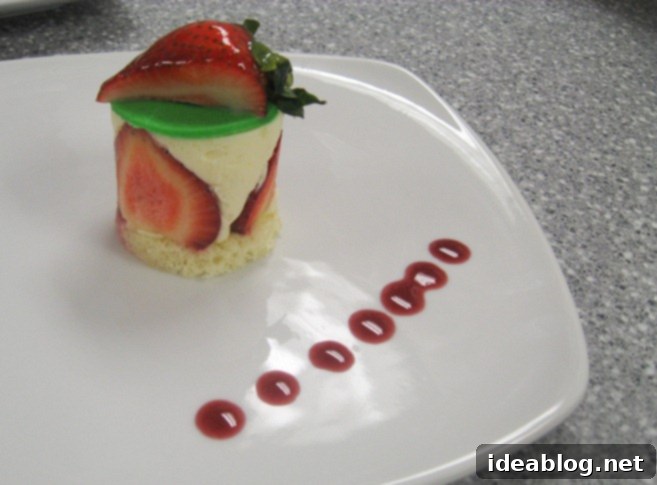A Culinary Journey: Mastering Classic Techniques and Conquering Market Basket Challenges
The intensity of our culinary program reached new heights last week, culminating in a demanding full day of production followed by an exhilarating Market Basket challenge. We were particularly honored to host Chef R.J. Cooper of Rogue24, a renowned restaurant in downtown DC, as our head judge for the challenge. His formidable reputation preceded him, adding an extra layer of pressure and excitement to the week’s end, truly putting our advanced culinary skills to the test.
The Art of Duck Pâté en Croûte: A Labor of Love
Our Thursday production began with an exquisite first course: duck pâté, elegantly encased in puff pastry and baked to golden perfection. This wasn’t a dish conceived on a whim; its preparation spanned several days, highlighting the importance of time and patience in classical French cuisine. We initiated the pâté’s creation at the very beginning of the week, allowing the rich mixture of duck, foie gras, and aromatic spices to marinate and develop profound flavors over three days. This extended marination period is crucial, transforming a simple ingredient list into a complex culinary masterpiece, a technique central to building depth in fine dining. Even for someone like me, who isn’t typically a pâté enthusiast, this version was truly exceptional – a testament to the culinary school’s commitment to refining and perfecting recipes over many years. This particular recipe has undergone countless tweaks and improvements, evolving into a hallmark dish that consistently impresses both students and instructors alike.
The most challenging aspect of this duck pâté en croûte lies in the delicate balance required when rolling out the puff pastry. It must be thin enough to cook completely through, creating that coveted flaky, golden texture, yet robust enough to prevent it from becoming soggy due to the pâté’s inherent moisture. A clever solution employed by our instructors involved fashioning small “chimneys” out of aluminum foil. These ingenious devices, visible as little silver protrusions on our sheet trays, serve a vital purpose: they allow steam to escape during baking, preventing the pastry from becoming waterlogged and ensuring a perfectly crisp crust. It’s these small, learned tricks that elevate a good dish to a great one, showcasing the precision and ingenuity required in professional cooking.
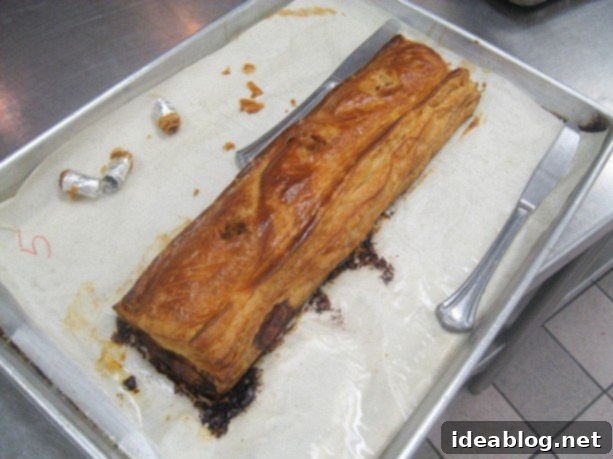
Once baked and cooled, we meticulously sliced the pâté, revealing its intricate layers and vibrant interior. Each serving was then adorned with a luxurious truffle sauce, a creation built upon a rich espagnole base, infused with finely diced shallots, sweet Madeira wine, and a harmonious blend of fresh herbs. To elevate the aroma and flavor profile further, a delicate drizzle of black truffle oil was added just before serving. My personal affinity for truffles meant this final touch was a pure delight, adding an earthy, sophisticated note that perfectly complemented the richness of the duck pâté. The combination was a symphony of textures and tastes, a true celebration of refined French culinary flavors and techniques.
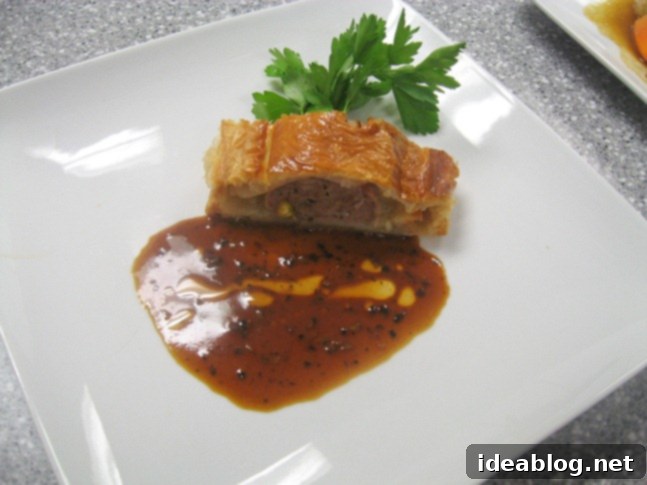
Crafting the Perfect Rack of Lamb: Precision Butchery and Global Flavors
Our main course was the magnificent rack of lamb, a classic centerpiece demanding both skill and precision in butchery and cooking. Each team was entrusted with the responsibility of meticulously trimming, Frenching, and portioning the full rack into individual double lamb chops. Trimming involves removing excess fat and silverskin to ensure even cooking, prevent smoking, and achieve a clean, professional presentation. Frenching, a classic butchery technique, requires carefully scraping the meat and fat from the ends of the rib bones, leaving them exposed and clean. This not only makes the chops more elegant but also concentrates the meat for a richer, more tender bite. Finally, portioning into double chops ensures a generous and satisfying serving size, showcasing the tender, flavorful meat with a balance of lean and rendered fat.
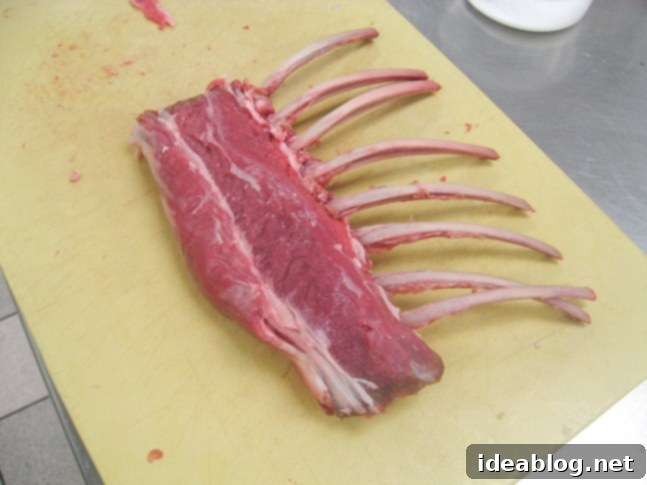
The succulent lamb chops were served with a vibrant Harissa jus, adding a touch of North African spice and warmth that beautifully complemented the richness of the lamb. Accompanying sides included fluffy couscous, tender chickpeas, and beautifully tourned vegetables – a precise classical cut that creates uniform, aesthetically pleasing barrel shapes, demonstrating fundamental knife skills. In addition to the lamb chops, we also featured grilled Merguez sausage, a spicy North African lamb sausage, which Chef Patrice had expertly demonstrated and prepared for us the previous afternoon. This provided a delicious contrasting flavor and texture, further enriching the main dish and showcasing a fusion of global culinary influences. The entire plate was a harmonious blend of flavors and textures, with the perfectly cooked lamb taking center stage, complemented by its robust and aromatic accompaniments. It was, without a doubt, a truly delicious and satisfying meal that highlighted our ability to integrate diverse elements into a cohesive dish.
A personal highlight (and a slightly terrifying one) involved trying my hand at using a massive cleaver to trim the bones. This particular task is incredibly intimidating, especially after having witnessed a minor, yet still unsettling, injury involving a cleaver back in Phase I of the program. The sheer weight and sharpness of the blade demand absolute focus, precision, and respect, making it a true test of one’s knife skills and composure under pressure. Successfully wielding it felt like a significant step forward in developing my confidence and proficiency in advanced butchery. It’s moments like these, where you push past your comfort zone and master challenging techniques, that truly define growth and expertise in a professional culinary education.
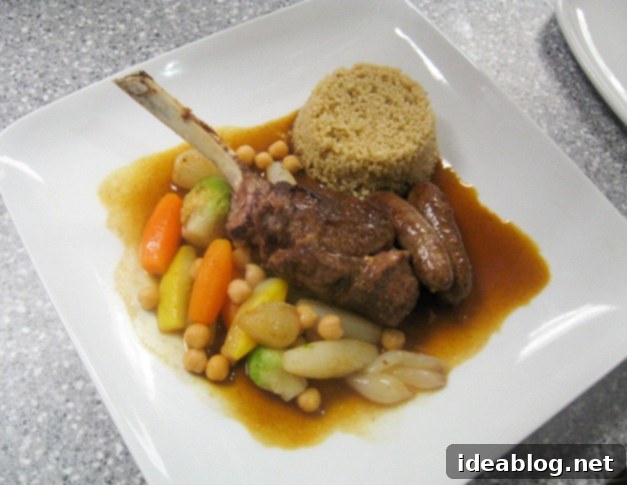
The Sweet Finale: Crafting Le Fraisier, a French Strawberry Cake
Our dessert of the day was the elegant Le Fraisier, a classic French strawberry cake that was every bit as delicious and artfully constructed as our savory dishes. The assembly of this delicate cake actually took place the afternoon prior, as it required an overnight stay in the refrigerator to properly set and firm up – a critical step in many patisserie creations. We meticulously molded these individual cakes in tall, cylindrical rings, creating their characteristic elegant shape. The foundation of Le Fraisier is a light and airy genoise sponge cake, which we conveniently had on hand in the freezer, ready to be thawed and brushed with a simple syrup to keep it moist and add a subtle sweetness, ensuring a tender base for the fruit and cream layers.
The true artistry began with carefully outlining the inner edge of each ring with perfectly sliced, vibrant strawberries, creating a beautiful visual border that is a hallmark of this dessert. The center was then generously filled with a luscious mixture of pastry cream, stabilized with gelatin for a smooth, firm texture, and folded with light, airy whipped cream. This combination yields a filling that is both rich and refreshing, a perfect counterpoint to the fresh fruit. The overnight chilling allows all these components to meld together, firming the structure and intensifying the flavors, resulting in a perfectly set and delicious dessert that melts in your mouth.
The following day, for decoration, we topped each Le Fraisier with a thin, precisely cut ring of vibrant green marzipan, adding a pop of color and a subtle almond flavor that complements the strawberries. A perfectly glazed strawberry finished the presentation, reflecting the light and inviting a first bite. The resulting dessert was wonderfully light, incredibly summery, and so utterly delightful that I could have easily indulged in several in one sitting. It strongly reminded me of a similar cake I had tested for my older sister’s upcoming wedding this August, highlighting the versatility and timeless appeal of such classic French patisserie preparations. Le Fraisier truly encapsulated the beauty, precision, and finesse of traditional French dessert making, a true testament to the elegance of simple, quality ingredients expertly combined.
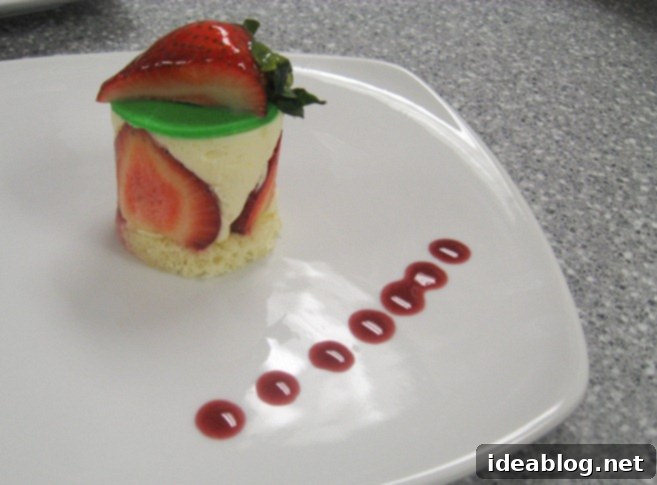
The Ultimate Test: Conquering the Market Basket Challenge
The afternoon following our main production day was dedicated to a different kind of challenge: discovering the mystery ingredients for the next day’s Market Basket challenge – our final one of the entire program! The anticipation was palpable as we learned our required components: a cold soup, a whole Rockfish, and fresh peaches. The combination immediately sparked creative thoughts, though some apprehension naturally followed. While the peaches smelled wonderfully fragrant, they unfortunately tasted bland and watery, a common issue given the season. Despite this hurdle, our teams embraced the challenge with resourcefulness and determination, committing to make the best of the ingredients provided, relying on our cumulative culinary training to transform them.
My partner Kevin and I strategized, brainstormed, and ultimately decided on the following menu for our presentation, aiming to highlight the key ingredients while showcasing our technical abilities:
Pan-Seared Rockfish Filet with Colcannon Pommes Roesti, Baby Carrots, and Lime Beurre Blanc
Caramelized Peach Bavarian Cream
The pressure of presenting to Chef R.J. Cooper was immense; his reputation for being a tough, discerning judge meant we were all a little apprehensive about his feedback. However, to our collective relief, he assessed our dishes favorably, stating that we had all performed well and that the food was genuinely good. His critical eye, combined with his positive remarks, was a huge affirmation of our progress and skill development throughout the program. In a surprising turn of events, every team actually tied for first place, a testament to the high standard of cooking achieved across the board. To break the tie and select a single winner, a deck of cards was employed, adding an element of chance to the high-stakes competition. The lucky team chosen by this random draw won an incredible prize: a stage (working interview) at Chef Cooper’s prestigious restaurant, followed by an exclusive 10-course meal. While my team didn’t win the stage, the experience of cooking under immense pressure for such a distinguished chef and receiving positive feedback was a victory in itself, profoundly valuable for our budding culinary careers and a memorable end to the challenges.
Transitioning to the Professional Kitchen: My Externship Begins
After a much-needed day off on Saturday, I eagerly stepped into my externship restaurant on Sunday night for my very first shift. The moment felt incredibly surreal, a culmination of months of intensive training, hard work, and countless hours honing my culinary skills. It’s still hard to fully grasp that in less than two weeks, I will be transitioning to a full-time role there, immersing myself completely in the fast-paced, demanding world of a professional kitchen. This externship marks the crucial bridge between rigorous culinary education and real-world application, an invaluable opportunity to hone my skills further, learn from seasoned professionals, and contribute to a professional team. The anticipation of learning and growing in this new, dynamic environment is immense, representing the next significant step in my journey to becoming a professional chef. I am incredibly excited about this next chapter and promise to share more details about my experiences and the exciting journey ahead very soon!
